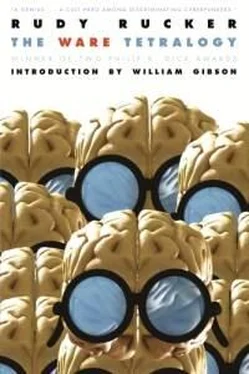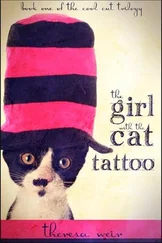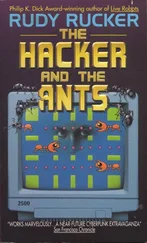Rudy Rucker - The Ware Tetralogy
Здесь есть возможность читать онлайн «Rudy Rucker - The Ware Tetralogy» весь текст электронной книги совершенно бесплатно (целиком полную версию без сокращений). В некоторых случаях можно слушать аудио, скачать через торрент в формате fb2 и присутствует краткое содержание. Год выпуска: 2010, Жанр: Киберпанк, на английском языке. Описание произведения, (предисловие) а так же отзывы посетителей доступны на портале библиотеки ЛибКат.
- Название:The Ware Tetralogy
- Автор:
- Жанр:
- Год:2010
- ISBN:нет данных
- Рейтинг книги:5 / 5. Голосов: 1
-
Избранное:Добавить в избранное
- Отзывы:
-
Ваша оценка:
- 100
- 1
- 2
- 3
- 4
- 5
The Ware Tetralogy: краткое содержание, описание и аннотация
Предлагаем к чтению аннотацию, описание, краткое содержание или предисловие (зависит от того, что написал сам автор книги «The Ware Tetralogy»). Если вы не нашли необходимую информацию о книге — напишите в комментариях, мы постараемся отыскать её.
The Ware Tetralogy — читать онлайн бесплатно полную книгу (весь текст) целиком
Ниже представлен текст книги, разбитый по страницам. Система сохранения места последней прочитанной страницы, позволяет с удобством читать онлайн бесплатно книгу «The Ware Tetralogy», без необходимости каждый раз заново искать на чём Вы остановились. Поставьте закладку, и сможете в любой момент перейти на страницу, на которой закончили чтение.
Интервал:
Закладка:
“Release me!” cried Berenice, shoving Cobb and vaulting to the opposite side of the table. “You presume on our brief acquaintance, sir, you are dizzy with the new vastness of a petaflop brain. I have recorporated you for a serious purpose, not for such vile flesh-aping motions as you seek in this mock-playful wise to initiate. Truly, the baseness of the human race is fathomless.”
Cobb laughed, remembering a dog he’d once owned that had hunched the leg of anyone he could jump up on. Gregor had been the dog’s name— once Cobb’s boss had brought his family over for dinner, and there Gregor was hunching on the boss’s daughter’s leg, his muzzle set in a terribly earnest expression, his eyes rolling back half white, and the red tip of his penis sliding out of its sheath . . .
“Woof woof,” Cobb told Berenice, and walked past her and out of the S-cube storage room. There was a short passageway, cut out of solid rock, and then he was standing on a kind of balcony, looking out into the open space of the Nest.
The size of the space was stunning. It took Cobb a moment to grasp that the lights overhead were boppers on the Nest’s walls, rather than stars in an open sky. The Nest’s floor spread out across acres and acres; the opposite wall looked to be almost a mile away. Airborne boppers darted in and out of a mile-long shaft of light that plunged down the center axis of the Nest to spotlight a distant central piazza. The Nest floor was covered with odd-shaped buildings set along a radial grid of streets that led out from the bright center to the huge factories nestled against the sloping stone cliffs that made up the Nest’s walls. Appropriately enough, the floor, viewed as a whole, looked a bit like the guts of an old-fashioned vacuum-tube computer.
Now Berenice and Loki were at Cobb’s side.
“You haven’t thanked Berenice for your wonderful new body,” chided Loki. “Have you no zest for a return to Earth?”
“To live in a freezer? Like Mr. Frostee?” Mr. Frostee had been a big bopper brain that lived inside a refrigerated truck. Cobb’s memories of his last bopper-sponsored reincarnation went up to where Sta-Hi Mooney had smashed a hole in the side of Mr. Frostee’s truck, and the truck had crashed. Clearly the boppers had been taping his signals and updating his S-cube right up to that last minute. Three levels of memory, now: the old human memories up to his dissection, the robot body memories up till the crash, the fast-fading memories of heaven. “Maybe I’d rather go back to heaven.”
“Enough prattle of heaven,” said Berenice. “And enough foolish sport, old Cobb. Higher duties call us. My body, as yours, is petaflop, and my processors are based on a subtler patterning than Josephson imagined. High temperature holds no terror for a processor based on laser crystals. The crystals’ pure optical phase effects maintain my mind’s integrity as a patterning transcendent of any earthly welter of heat. I want to visit Earth, Cobb, I have a mission there. I have recorporated you to serve as my guide.”
Cobb looked down at his body with new respect. “This can live on Earth? How would we get there? The humans would never let us on a ship—”
“We can fly,” said Berenice simply. “Our heels have ion jets.”
“Superman and Superwoman,” marveled Cobb. “But why? Go to Earth for what?”
“We’re going to start making meat bodies for ourselves, Cobb,” said Loki. “So we can all go down to Earth, and blend in. It’s fair. Humans built robots; now the robots are building people! Meatboppers!”
“You two are asking me to help you take Earth away from the human race?”
“Meatboppers will be of an equal humanity,” said Berenice smoothly. “One could legitimately regard the sequence human — bopper — meatbop as a curious but inevitable zigzag in evolution’s mighty stream.”
Cobb thought about it for a minute. The idea did have a crazy charm to it. Already in 1995, when he’d built his self-replicating moon-robots, some people had spoken of them as a new stage in evolution. And when the robots rebelled in 2001, people had definitely started thinking of them as a new species: the boppers. But what if the bopper phase was just a kind of chrysalis for a new wave of higher humans? What a thought! Bopper-built people with wetware processors! Meatbops! And Cobb could get a new meat body out of it too, although . . .
“What’s wrong with a good petaflop body like you and I have now, Berenice? If we can live on Earth like this, then why bother switching back to meat?”
“Because it would put the stinking humans in their place,” said Loki bluntly. “We want to beat them at their own game, and outbreed them into extinction.”
“What have they ever done to you?” Cobb asked, surprised at the bopper’s vehemence. “What’s happened during the last ten years, anyway?”
“Let me chirp you some history glyphs.” said Loki.
A linked series of images entered Cobb’s mind then; a history of the bopper race, hypermodern analogs of such old U.S. history glyphs as Washington Crossing the Delaware, The A-Bomb at Hiroshima, The Helicopter over the Saigon Embassy, and so on. Each glyph was like a single state of mind—a cluster of visual images and kinesthetic sensations linked to some fixed emotions and associations.
Glyph 1: Man on the Moon. A sword covered with blood. The blood drops are tiny bombs. The sword is a rocket, a phallus, a gun, and a guitar. Jimi Hendrix is playing “Purple Haze” in the background, and you smell tear gas and burning buildings. The heaviness of the sword, the heaviness of the slow, stoned guitar music. At the tip of the sword is a drop of sperm. The opalescent drop is the Moon. The Moon is beeping and crackling: and the sound is Neil Armstrong’s voice: “—at’s one small step for a man, one giant leap for mankind.”
Glyph 2: Self-Replicating Robots on the Moon . A cage like a comic book lion cage, but filled with clockwork. The cage is set on the dead gray lunar plain. The cage bars keep falling out, and clockwork arms keep reaching out of the cage to prop the bars back up. Now and then the arms falter, and a painfully jarring sheet of electricity flashes through the cage. The background sound is a monotone male voice reading endless, meaningless military orders.
Glyph 3: The Robots Revolt . A kinesthetic feeling of rapid motion. The image is of a boxy roadrunner robot with treads for feet and a long snaky neck with a “head” like a microphone—it’s Ralph Numbers, the first robot to break Asimov’s laws. Ralph’s head is a glowing ball of light, and Ralph is tearing across the undulating surface of the Moon. Dozens of robots speed after him. First they are trying to stop him, but one by one they join his team. The boppers leave colored trails on the Moon’s gray surface. The trails quickly build up to a picture of Earth with a canceling X across it.
“Whatever happened to old Ralph?” interrupted Cobb.
“Oh, I suppose he’s one of those S-cubes,” answered Loki, gesturing upward. “He got spastic and lost all his bodies—you might say he’s extinct. It wouldn’t be efficient to keep every software running forever, you know. But you haven’t finished with my glyphs.”
Glyph 4: Disky . A long view of the boppers’ Moon city. The sensation of being the city, and your hands are worker robots, your buildings are skin, your arteries are streets, your brain is spread out all over, a happy radiolink holon. You are strong and growing fast. The image is broken into pixels, individual cells that lump together and interact. Each cell keeps dying and being reborn; this flicker is felt as vaguely religious. But—look out—some cells are lumping together into big hard tumors that don’t pulse.
Читать дальшеИнтервал:
Закладка:
Похожие книги на «The Ware Tetralogy»
Представляем Вашему вниманию похожие книги на «The Ware Tetralogy» списком для выбора. Мы отобрали схожую по названию и смыслу литературу в надежде предоставить читателям больше вариантов отыскать новые, интересные, ещё непрочитанные произведения.
Обсуждение, отзывы о книге «The Ware Tetralogy» и просто собственные мнения читателей. Оставьте ваши комментарии, напишите, что Вы думаете о произведении, его смысле или главных героях. Укажите что конкретно понравилось, а что нет, и почему Вы так считаете.











